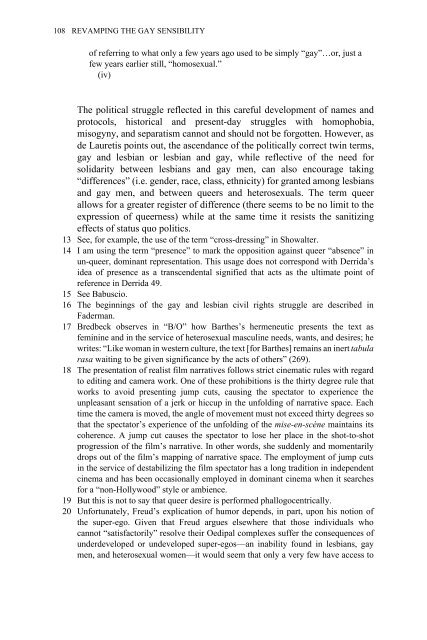Edited by Moe Meyer - Get a Free Blog
Edited by Moe Meyer - Get a Free Blog
Edited by Moe Meyer - Get a Free Blog
Create successful ePaper yourself
Turn your PDF publications into a flip-book with our unique Google optimized e-Paper software.
108 REVAMPING THE GAY SENSIBILITY<br />
of referring to what only a few years ago used to be simply “gay”…or, just a<br />
few years earlier still, “homosexual.”<br />
(iv)<br />
The political struggle reflected in this careful development of names and<br />
protocols, historical and present-day struggles with homophobia,<br />
misogyny, and separatism cannot and should not be forgotten. However, as<br />
de Lauretis points out, the ascendance of the politically correct twin terms,<br />
gay and lesbian or lesbian and gay, while reflective of the need for<br />
solidarity between lesbians and gay men, can also encourage taking<br />
“differences” (i.e. gender, race, class, ethnicity) for granted among lesbians<br />
and gay men, and between queers and heterosexuals. The term queer<br />
allows for a greater register of difference (there seems to be no limit to the<br />
expression of queerness) while at the same time it resists the sanitizing<br />
effects of status quo politics.<br />
13 See, for example, the use of the term “cross-dressing” in Showalter.<br />
14 I am using the term “presence” to mark the opposition against queer “absence” in<br />
un-queer, dominant representation. This usage does not correspond with Derrida’s<br />
idea of presence as a transcendental signified that acts as the ultimate point of<br />
reference in Derrida 49.<br />
15 See Babuscio.<br />
16 The beginnings of the gay and lesbian civil rights struggle are described in<br />
Faderman.<br />
17 Bredbeck observes in “B/O” how Barthes’s hermeneutic presents the text as<br />
feminine and in the service of heterosexual masculine needs, wants, and desires; he<br />
writes: “Like woman in western culture, the text [for Barthes] remains an inert tabula<br />
rasa waiting to be given significance <strong>by</strong> the acts of others” (269).<br />
18 The presentation of realist film narratives follows strict cinematic rules with regard<br />
to editing and camera work. One of these prohibitions is the thirty degree rule that<br />
works to avoid presenting jump cuts, causing the spectator to experience the<br />
unpleasant sensation of a jerk or hiccup in the unfolding of narrative space. Each<br />
time the camera is moved, the angle of movement must not exceed thirty degrees so<br />
that the spectator’s experience of the unfolding of the mise-en-scène maintains its<br />
coherence. A jump cut causes the spectator to lose her place in the shot-to-shot<br />
progression of the film’s narrative. In other words, she suddenly and momentarily<br />
drops out of the film’s mapping of narrative space. The employment of jump cuts<br />
in the service of destabilizing the film spectator has a long tradition in independent<br />
cinema and has been occasionally employed in dominant cinema when it searches<br />
for a “non-Hollywood” style or ambience.<br />
19 But this is not to say that queer desire is performed phallogocentrically.<br />
20 Unfortunately, Freud’s explication of humor depends, in part, upon his notion of<br />
the super-ego. Given that Freud argues elsewhere that those individuals who<br />
cannot “satisfactorily” resolve their Oedipal complexes suffer the consequences of<br />
underdeveloped or undeveloped super-egos—an inability found in lesbians, gay<br />
men, and heterosexual women—it would seem that only a very few have access to


